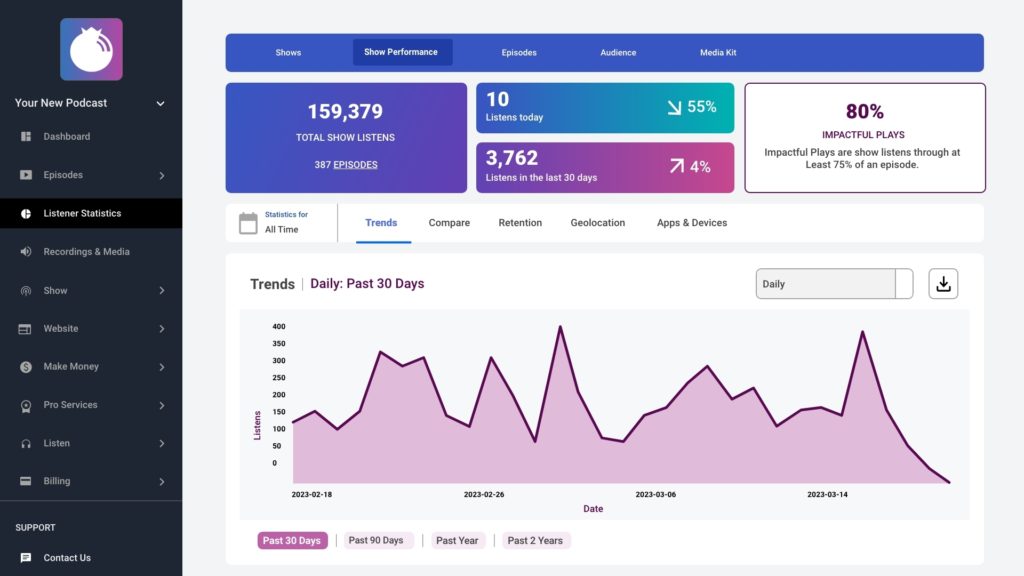 Podcasting is a significant player in the media and entertainment industries, and podcast statistics are essential to its success. With more creators producing content and a diverse array of topics covered, it stands to reason that podcast industry statistics reveal a fascinating growth trajectory and an expanding audience base. And it’s no surprise that Blubrry Podcasting is in the lead in offering intuitive and comprehensive podcast statistics.
Podcasting is a significant player in the media and entertainment industries, and podcast statistics are essential to its success. With more creators producing content and a diverse array of topics covered, it stands to reason that podcast industry statistics reveal a fascinating growth trajectory and an expanding audience base. And it’s no surprise that Blubrry Podcasting is in the lead in offering intuitive and comprehensive podcast statistics.
Let’s delve into various aspects of podcast statistics, including audience statistics, projections for the podcast industry in 2023, and other relevant podcasting data and stats.
The rise of podcasts can be attributed to several factors, such as:
- Increased smartphone use
- Better internet connectivity
- Growing interest in on-demand audio content
Podcast industry statistics show over 4 million podcasts worldwide in 2023, with nearly 600,000 publishing a new episode at least monthly. The United States leads the global charts, with over half of these podcasts originating from the U.S. alone.
Podcast audience statistics paint an interesting picture regarding listener demographics, preferences, and habits. Studies have shown that around 50% of Americans aged 12 and above have listened to at least one podcast episode. Moreover, about 28% of them are monthly listeners, translating to approximately 80 million people consuming podcast content regularly. These numbers are expected to grow further as podcasts continue to gain traction among different age groups and communities.
According to some predictions, podcast revenue is expected to surpass $2.5 billion by 2023, representing a massive leap from just $314 million in 2017. This projected growth indicates that businesses recognize the value of investing in podcasts as a marketing strategy.
Analyzing future trends becomes even more critical when considering podcast statistics for 2024. Experts predict that technological advancements such as smart speakers will further propel the popularity of podcasts among consumers across the globe.
In addition, the continued expansion of prominent podcast platforms such as Spotify and Apple Podcasts and investments in exclusive content deals will undoubtedly contribute to the industry’s growth over the next few years.
Why is podcast data showcasing so much growth?
One essential aspect of podcasting data that cannot be ignored is listener engagement. Studies have found that podcast listeners are typically more engaged with the content they consume than other media formats. This is reflected in metrics such as average listening time per episode, which often exceeds 30 minutes for popular shows.
Additionally, research has demonstrated that podcast listeners are more likely to take action based on advertising within podcasts than traditional radio ads, which makes them highly valuable.
Podcast stats reveal a thriving industry that continues to grow rapidly. With increasing audience numbers, expanding ad revenues, and promising projections for 2023 and beyond, there is no doubt that podcasts are becoming an integral part of our media landscape.
As technology evolves and creators continue to innovate in content and formats, it will be interesting to see how these trends shape the future of podcasting. The ever-evolving world of podcasts presents not only exciting opportunities for creators but also serves as a testament to the power of on-demand audio and video content in capturing the hearts and minds of audiences worldwide.
Podcast Metrics and Data Analysis
 The world of podcasting has grown exponentially in recent years, bringing a plethora of listener statistics and data that need to be analyzed for success. These metrics are critical in understanding the performance of any podcast and can guide creators on how to improve their content and grow their audience.
The world of podcasting has grown exponentially in recent years, bringing a plethora of listener statistics and data that need to be analyzed for success. These metrics are critical in understanding the performance of any podcast and can guide creators on how to improve their content and grow their audience.
Let’s take a look at the significance of podcast data analysis and various metrics, such as podcast download statistics and growth statistics, all aimed at providing valuable insights for creators.
Podcast listener statistics are essential in understanding who is tuning into your show and what resonates with them. By analyzing these numbers, podcasters can identify patterns that help them tailor their content more effectively, reaching new audiences while retaining their current followers. Demographic data such as age, gender, location, and interests assist in crafting compelling narratives tailored to specific groups.
However, gathering information on listeners can be challenging due to privacy concerns and varying listening platforms. Still, some tools offer anonymous aggregate data that can provide valuable insights without infringing on personal privacy.
Podcast hosting services often provide analytics functionality, including listener demographics or geographical information.
Podcast download statistics matter.
Another crucial aspect of podcast metrics is monitoring download statistics. Downloads are the most common way listeners consume podcasts; thus, this metric is a reliable indicator of engagement with your content. Analyzing trends in download numbers over time allows you to gauge the effectiveness of marketing efforts or potential reasons for fluctuations in listenership.
A sudden spike in downloads after a particular marketing campaign or guest appearance may indicate successful promotional tactics worth exploring. Conversely, a drop in downloads could signify issues with content quality or lackluster audience engagement requiring prompt attention.
Keeping an eye on download statistics also helps determine which episodes perform better than others, offering insights into topics or formats that resonate most with your audience. This has become more accessible than ever before with Blubrry Podcasting’s Progressive Web App (PWA).
Monitoring podcast growth statistics is necessary.
 Tracking podcast growth statistics is essential for long-term success as it provides valuable information about whether your show is expanding its reach over time or stagnating.
Tracking podcast growth statistics is essential for long-term success as it provides valuable information about whether your show is expanding its reach over time or stagnating.
Monitoring subscriber numbers and social media followers can give you a sense of your podcast’s visibility and influence in the industry. By examining growth trends, podcasters can determine which strategies are effective at drawing in new listeners while maintaining the interest of their existing audience. Measuring growth is not limited to raw numbers.
Audience engagement can also be assessed through metrics such as:
- Average listening time
- Completion rate (the percentage of listeners who finish an episode)
- Percentage of episodes played from a listener’s library
High engagement rates often signify strong audience loyalty and compelling content worth investing more effort into creating. Podcasting metrics serve as a valuable toolset for creators to evaluate their content’s performance and make informed decisions for future growth initiatives or improvements.
Whether analyzing podcast listener statistics, download data, or growth trends, employing these quantitative measures helps ensure long-lasting success in this ever-evolving medium. Overall, understanding Podcast Metrics and Data Analysis enables podcasters to optimize their content strategy by refining their messaging based on audience preferences and behavior patterns. Embracing these insights drives more profound connections with listeners and fosters sustainable growth in this competitive landscape where captivating storytelling reigns supreme.
Utilizing Podcast Statistics
Utilizing podcast statistics is essential in maximizing your podcast content’s potential. Podcast statistics provide valuable insights into podcast performance metrics and engagement metrics that can aid in making informed decisions about the direction of your podcast. Consider the various aspects of podcast statistics, including monetizing podcasts and understanding podcast marketing statistics.
Podcast performance metrics are crucial indicators of how well your podcast content resonates with your audience. These metrics can include data such as
- Number of unique downloads
- Average listening time
- Completion rates
Blubrry Podcasting leads the industry in providing these important statistics in a comprehensive dashboard. By closely monitoring these metrics, you can identify trends and patterns in your audience’s listening behavior. This information allows you to make necessary adjustments to optimize your content strategy for maximum impact. Discovering effective ways to monetize a podcast is another critical aspect of utilizing podcast statistics.
Podcast statistics help monetization.
 Podcast statistics play a pivotal role in monetizing a podcast by providing invaluable insights into audience behavior and engagement. These metrics, ranging from download numbers and listener demographics to retention rates and listener location, empower podcasters and advertisers to make informed decisions. With a clear understanding of their audience, podcasters can tailor content, refine their marketing strategies, and attract sponsors that align with their listeners’ interests. Advertisers can leverage this data to identify the most suitable shows for their target audience, ensuring their investments yield higher returns. Ultimately, podcast statistics guide podcast creators and advertisers toward successful monetization in a rapidly evolving and competitive industry. Learn more about podcast statistics and monetization.
Podcast statistics play a pivotal role in monetizing a podcast by providing invaluable insights into audience behavior and engagement. These metrics, ranging from download numbers and listener demographics to retention rates and listener location, empower podcasters and advertisers to make informed decisions. With a clear understanding of their audience, podcasters can tailor content, refine their marketing strategies, and attract sponsors that align with their listeners’ interests. Advertisers can leverage this data to identify the most suitable shows for their target audience, ensuring their investments yield higher returns. Ultimately, podcast statistics guide podcast creators and advertisers toward successful monetization in a rapidly evolving and competitive industry. Learn more about podcast statistics and monetization.
As most podcasts rely on advertising revenue or sponsorships to sustain their production costs, understanding who your listeners are and their interests can help attract sponsors who align with your target demographic. By examining engagement metrics such as listener demographics and geographic locations, you can hone in on specific markets most receptive to advertisements from relevant sponsors. Engagement metrics are also essential to understanding how invested your audience is in your podcast content.
Metrics such as the following provide valuable insight into how well the podcast performs.
- Social media shares
- Comments
- Ratings
- Reviews
When analyzing these engagement metrics alongside the aforementioned performance metrics, you gain a more comprehensive view of each episode’s quantity and quality of reach.
Another important aspect of utilizing podcast statistics is leveraging them for successful marketing strategies. Podcast marketing statistics help creators identify which promotional channels yield the highest return on investment (ROI) for their efforts to drive new listenership or increase overall engagement levels among existing subscribers.
For example, you can refine your marketing strategies and allocate resources more effectively by evaluating the effectiveness of different social media platforms or targeted email campaigns based on click-through rates or conversions. Learn more about marketing your podcast in Blubrry’s free Podcast Manual.
Utilizing podcast statistics is vital in ensuring your podcast content’s success. By monitoring podcast performance metrics and engagement metrics, you can make data-driven decisions to optimize your content for maximum impact. Additionally, understanding your audience’s demographics helps with monetizing podcasts by attracting relevant sponsors and advertisers.
Meanwhile, Blubrry makes it easy to showcase your podcast’s strengths to prospective advertisers with its free Media Kit, which features the insights you want to share and updates daily.
Lastly, analyzing podcast marketing statistics allows you to make informed decisions on which promotional channels yield the highest ROI for growing your audience. With these insights, you are better equipped to take full advantage of this rapidly growing medium and achieve continued success with your podcast endeavors.




